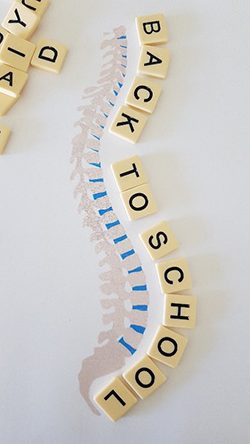
It’s that time again, a new school year, you have the book lists, you’ve covered the books, lunch boxes are filled with healthy snacks and you’ve made sure your child has everything they need in their school back pack. And then on it goes and before you know it, your child is complaining of back or shoulder pain. So how can you get back to school without over loading their growing spines?
- Choosing the back pack – choose a back pack that is suitable for your child’s size, a bigger pack is not necessarily better for them. The pack should not extend below their bottom.
- Find a bag that has wide, padded straps; this will help distribute the load across their shoulders. Use of chest and hip belts is also recommended to support the weight of the back better.
- Tighten up the straps so that the bag sits snug to your child’s body and does not hang too low, this will reduce extension of the spine and a corresponding stoop forward trying to maintain balance.
- Lighten the load. It is recommended that they should only carry between 10-15% of their body weight. If you are not sure, put the backpack on a scale and work out what % of their body weight it is. Take out nonessential items and check the bag regularly to make sure they are not carrying around things they do not need.
- Symmetry is the aim – perhaps the hardest thing to achieve especially with your teenagers but carrying the back pack on both shoulders is ideal. This evens out the load and reduces the risk of straining muscles that are having to counteract a lopsided spine. An alternative is use of a messenger bag as along as it is carried diagonally across the body.
- If you lose the battle at least encourage your teenager to switch their bag from one side to the other throughout the day.
- Have a designated work station and get your children to sit at a desk or table when they do their homework. The essentials of sitting at a work space are to have both feet on the floor or on a box if their feet do not reach the ground. Bottom back in the chair and the chair pulled up close to the desk. Their forearms should rest comfortably on the table top with elbows bent to 90-degree angle. You may need to raise the height of the chair. Good sitting posture is not just ideal for their backs but reducing the work of the postural muscles actually allows more energy to attend to the task at hand. Seating your child correctly will improve their educational outcomes too, it is important.
- Limit screen time. This is important on so many accounts, but also when we consider posture. Most children spend hours gamming on their tummy and while this position can be great for back strength in short bursts, it can have negative effects on their cervical spine over prolonged periods. If you have access to a small gym ball, have your child do their gamming time sitting on a ball, this will encourage good posture and work on core strength. You can get a gym ball through your local physiotherapist.
- Encourage regular physical activity; enrol your child in a sport or just get them out into the back yard every day. This is a good time for you to join in a game, spend some one on one time with them and get your fitness goals under wraps too. Jumping on the trampoline with my kids taught me more about simple fun and belly laughs (not to mention my pelvic floor) than any other activity we did together.
- Finally, if you have concerns about your child’s posture or if they are complaining of pain, book an appointment with me, I have years of experience working as an early developmental paediatric physiotherapist as well as musculoskeletal expertise. Physio can be fun, and you will learn something yourself when you implement the exercises is a fun way at home.
